As of noon today, I have maintained a perfect record of submitting my grade rolls within 5 minutes of the deadline every semester this year. This may be a good indicator of the level of stress created by my mother/teacher life. Or just a sign that I am as much of a procrastinator as I was when I was a student and sitting on the other end of those grades.
In my own defense, I was pretty busy the week before Christmas and had no time – or desire – to finish grading final exams. So I set them aside and wound up spending most of the day yesterday and well into the wee hours of the morning getting them done. I can tell I’ve aged a bit since my student days because I’m wiped out today from the sleep-deprivation. In my golden years I could have simply downed a Coke and been good to go. But now I’m an old lady and 3 hours of sleep just doesn’t do it for me.
Well at least the grades are done and I can start worrying about next semester, which starts in a week. And I did have a few laughs in the middle of the night when I came across little gems like this one in a student essay: “The turning point was World War I. This was almost the same as the French Revolution but slightly different.”
Maybe it was funnier at 2 am. But since I’m running on fumes today, it still amuses me.
Friday, December 29, 2006
Wednesday, December 27, 2006
S...crapbooking
I do not scrapbook. I am not a scrapbooker. I lack the patience, the money and the fancy scissors. Don’t get me wrong – I do not frown upon others of the scrapbooking inclination (my fabulous sister-in-law Jen being one of them). In fact, I admire them and covet their fancy scissors. But after years of self-banishment to the desert of Motherhood Inadequacy for producing nothing cute and texturally significant with my piles of photos, I have reached the oasis of Whatever. My new daily affirmation: “I am still a good mother even if I have never pasted a photo of my son playing soccer onto an artfully edged oval of paper adorned with little soccer balls and the word SOCCER! stamped across it diagonally.” Also I sometimes use: “My life can be complete without owning hundreds of dollars worth of stickers.”
I am intrigued by the fact that Utah is the scrapbooking capital of the world. Apparently we rock in the highly touted statistic of fancy scissors per capita (this being made all the more impressive by the percentage of our population who are under the age of 5 and have no business owning sharp objects, even if they are multi-colored and fun to play with). I think the Mormon admonition to do genealogy* has something to do with this. Somehow the scrapbook culture has turned genealogy into a creative outlet, a fashion statement, and a suburban status symbol. And the guilt normally associated with expensive, time-consuming hobbies is appeased because “Hey, I’m doing my family history.” Case in point: the vogue term for a paragraph of text (typed in font that looks like handwriting, artfully centered within a frame, and secured to the page with fake color-coordinated brads) is "journaling."
*The fact that I cannot spell this word without a search is a sign that I have not done mine. I do not genealogize. I am not a genealogizer. Clearly I am a slacker of gargantuan proportions and do not deserve to live in Utah. If Utah were Junior High, I would be the looser kicking rocks by the fence while everyone else busied themselves with Rubik’s cubes.
The kind of scrapbooking that makes me laugh and feel superior (because if you can’t join them, you must mock them) is where 21 layers of paper and an arsenal of stickers, stamps, ribbons and other 3-dimensional bits of collage-gone-wild are unleashed upon a page in order to create the ideal setting for exactly one (1) photo. This is scrapbooking only in the same sense that Extreme Makeover Home Edition is about remodeling. Yeah, right. Let’s just tell the truth and call it fanatical framing.

Extreme scrapbooking reminds me of those Baroque paintings (like this one by Claude Lorrain) that are given titles like The Flight of the Holy Family into Egypt but are mostly an excuse for big landscapes with elaborate trees. Jesus, Mary and Joseph are almost an afterthought. In his version (below), Annibale Carracci even took the time to curve the top edge. All he lacked was the fancy scissors. Which were invented, by the way, by Leonardo da Vinci who drew sketches of fancy scissors in his notebooks but never got around to building them.
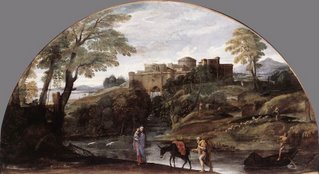
Where did this rant come from anyway? Well, you see I lied when I said I do not scrapbook, because every year I produce a grand total of 3 scrapbook pages. I do this to appease the scrapbook gods who hate me and may hurl my disdainful body into the volcano if I don’t make the offering. No, actually I do it because four years ago, my family simplified the tradition of the gift exchange and now we each make a few scrapbook pages to share. In all sincerity I think this is a great idea. I love having pictures and “year in review” summaries from my siblings and their kids (and dogs). Originally the logic was that instead of spending money on a gift, we would spend it on making color copies for everyone (which with 9 siblings does add up). In reality, my mother usually winds up paying for most of the copying which is another reason why I love this tradition. Wahoo! A cheap gift.
But not an easy gift. Because here I am, two days after Christmas, still working on my pages. I got the brilliant idea this year that I would get some digital scrapbooking software and avoid the paper cuts. All of my photos are on my computer anyway. I downloaded some nifty backgrounds and got started cropping my photos and outlining them in coordinating colors. “This is great!” I thought, “Why doesn’t everyone scrapbook this way?” Well, as I added a few more pictures to my page, I discovered why. Apparently, one digital scrapbook page consumes roughly the same amount of RAM it takes NASA Mission Control to launch a space shuttle. Even the smallest adjustments take forEVER to compute. I move one photo a half inch and the dreaded hourglass appears, the squirrels inside my computer groan under the strain, and I might as well go make myself a sandwich while I’m waiting. Half the time, the job is too much and I guess the squirrels keel over and die because my computer is hopelessly frozen when I return. As I see it, my options are these: 1) give up and risk being disowned by my family, 2) develop a year’s worth of film, get out my boring scissors, and do my best with the old-fashioned paper method, or 3) throw myself into the volcano.
I am intrigued by the fact that Utah is the scrapbooking capital of the world. Apparently we rock in the highly touted statistic of fancy scissors per capita (this being made all the more impressive by the percentage of our population who are under the age of 5 and have no business owning sharp objects, even if they are multi-colored and fun to play with). I think the Mormon admonition to do genealogy* has something to do with this. Somehow the scrapbook culture has turned genealogy into a creative outlet, a fashion statement, and a suburban status symbol. And the guilt normally associated with expensive, time-consuming hobbies is appeased because “Hey, I’m doing my family history.” Case in point: the vogue term for a paragraph of text (typed in font that looks like handwriting, artfully centered within a frame, and secured to the page with fake color-coordinated brads) is "journaling."
*The fact that I cannot spell this word without a search is a sign that I have not done mine. I do not genealogize. I am not a genealogizer. Clearly I am a slacker of gargantuan proportions and do not deserve to live in Utah. If Utah were Junior High, I would be the looser kicking rocks by the fence while everyone else busied themselves with Rubik’s cubes.
The kind of scrapbooking that makes me laugh and feel superior (because if you can’t join them, you must mock them) is where 21 layers of paper and an arsenal of stickers, stamps, ribbons and other 3-dimensional bits of collage-gone-wild are unleashed upon a page in order to create the ideal setting for exactly one (1) photo. This is scrapbooking only in the same sense that Extreme Makeover Home Edition is about remodeling. Yeah, right. Let’s just tell the truth and call it fanatical framing.

Extreme scrapbooking reminds me of those Baroque paintings (like this one by Claude Lorrain) that are given titles like The Flight of the Holy Family into Egypt but are mostly an excuse for big landscapes with elaborate trees. Jesus, Mary and Joseph are almost an afterthought. In his version (below), Annibale Carracci even took the time to curve the top edge. All he lacked was the fancy scissors. Which were invented, by the way, by Leonardo da Vinci who drew sketches of fancy scissors in his notebooks but never got around to building them.

Where did this rant come from anyway? Well, you see I lied when I said I do not scrapbook, because every year I produce a grand total of 3 scrapbook pages. I do this to appease the scrapbook gods who hate me and may hurl my disdainful body into the volcano if I don’t make the offering. No, actually I do it because four years ago, my family simplified the tradition of the gift exchange and now we each make a few scrapbook pages to share. In all sincerity I think this is a great idea. I love having pictures and “year in review” summaries from my siblings and their kids (and dogs). Originally the logic was that instead of spending money on a gift, we would spend it on making color copies for everyone (which with 9 siblings does add up). In reality, my mother usually winds up paying for most of the copying which is another reason why I love this tradition. Wahoo! A cheap gift.
But not an easy gift. Because here I am, two days after Christmas, still working on my pages. I got the brilliant idea this year that I would get some digital scrapbooking software and avoid the paper cuts. All of my photos are on my computer anyway. I downloaded some nifty backgrounds and got started cropping my photos and outlining them in coordinating colors. “This is great!” I thought, “Why doesn’t everyone scrapbook this way?” Well, as I added a few more pictures to my page, I discovered why. Apparently, one digital scrapbook page consumes roughly the same amount of RAM it takes NASA Mission Control to launch a space shuttle. Even the smallest adjustments take forEVER to compute. I move one photo a half inch and the dreaded hourglass appears, the squirrels inside my computer groan under the strain, and I might as well go make myself a sandwich while I’m waiting. Half the time, the job is too much and I guess the squirrels keel over and die because my computer is hopelessly frozen when I return. As I see it, my options are these: 1) give up and risk being disowned by my family, 2) develop a year’s worth of film, get out my boring scissors, and do my best with the old-fashioned paper method, or 3) throw myself into the volcano.
Friday, December 22, 2006
On raising doubters
 I’ll start with today’s painting first – Caravaggio’s Doubting Thomas. I love Caravaggio’s incredible realism, from the trademark wrinkled foreheads to the open wound in Christ’s side. Ironically, the painting is a masterful illusion (it’s really just paint on canvas after all) about those who rely too much on their senses. Thomas had to see to believe. In fact he had to feel to believe. But does touching the resurrected body of Jesus really make Thomas a believer? Or is he just a skeptic with evidence?
I’ll start with today’s painting first – Caravaggio’s Doubting Thomas. I love Caravaggio’s incredible realism, from the trademark wrinkled foreheads to the open wound in Christ’s side. Ironically, the painting is a masterful illusion (it’s really just paint on canvas after all) about those who rely too much on their senses. Thomas had to see to believe. In fact he had to feel to believe. But does touching the resurrected body of Jesus really make Thomas a believer? Or is he just a skeptic with evidence? When our first child was born (and perhaps even before), Ken and I had the big “to Santa or not to Santa” discussion. We both agreed that we never wanted to lie to our kids, under any circumstances, and it just seemed wrong to make an exception for an elf – even if he had been an elf who loomed large in our own childhoods. Some of my siblings have talked about the disillusionment they felt when they discovered the truth about Santa and how this shook their faith in parental honesty. I never felt that way at all. If anything, when I found out what they had been up to, I was blown away by the years of effort and selflessness it took for my parents to maintain the myth. Perhaps there was no enchanted sleigh or flying reindeer, but my parents worked some serious magic to buy presents for 9 children on a teacher’s salary and keep it all a secret for as long as they did. Being a selfish, manipulative mother myself, I doubt I could ever pull it off even if I wanted to. I strive to keep my kids keenly aware of every sacrifice I make on their behalf. No way am I going to let anybody else – especially a make-believe somebody else – take the credit.
Ken and I have told the kids that Santa Claus is a wonderful symbol of generosity, but just a symbol. We remind them that some of their friends may believe in Santa so they should be careful not to spoil things for them. We also try to downplay the material aspects of the holiday and focus on the spiritual ones. In the end, I have been surprised at how easy it has been to simply leave Santa out of the picture. We don’t mention him. The kids don’t seem to miss him. And Christmas morning is still full of delight, stockings, surprises, and presents out the wazoo (so much for downplaying the material). One thing I do love is that my boys are more excited to see how their siblings will like the presents they picked out for them than to see what they are getting.
Still, in the very act of congratulating myself for blockading our chimney from the delivery of Santa-baggage, I am wondering if my kids are someday going to resent me for it. In 15 years they’ll probably be blogging away about how their mom deprived them of Christmas magic and stole their childhood. And I’m not sure I would blame them. So much of adulthood is about being practical and cynical. What if they would prefer at least a few years of childish illusion before they enter too soon into the “real” world – a world where plenty of people will lie to them, not out of love or a sense of tradition, but to sell them something or earn their vote. My children have the rest of their lives to be skeptics. What’s the rush?
Saturday, December 16, 2006
crumbs
Help. Is it blogger’s block or just Christmas stress on the brain? I’m not sure, but I’m having a hard time getting anything written. I’ve started several posts, but as I type, the words assemble themselves into sickly pulp before my eyes. Maybe I’m not a writer after all. The voices in my head are taunting me. And they’re asking for Snicker’s bars. I must obey.
Part of the problem is that I want to write about the package of ancient cheese-and-crackers Ken found in the cupboard yesterday. The cheese had solidified and turned a disturbing shade of brown. The kids suggested that perhaps it had fermented into chocolate and was still edible. I don’t think that’s possible, but I’m no chemistry major or anything.
See? That’s pretty blogable material. Deep. Thought-provoking. Covers two of the major food groups. But I can't think of a way to tie in a work of Christmas art. I have yet to find a nativity painting with processed cheese. Not that there aren’t any out there, because if people can make modern sculptures out of elephant dung, anything is possible.
I realize that I talk a lot about food on my blog. I’m not sure why this is. I’ll check with the voices and get back with you. In the meantime, here’s a running tally:
decapitated broccoli
Snicker’s bars (twice)
Crocodiles who eat human hearts and Satan eating sinners (do those count?)
roasting marshmallows in hell
cilantro (blech!)
Ramen noodles (twice)
cereal (thrice)
pizza
rootbeer
saltine crackers
Campbell’s tomato soup
frankfurter roasts
whole wheat bread
avoiding making bread
breaking a bone while making bread
cinnamon toast
crockpot roast
home made rolls
Halloween candy (twice)
chocolate (a few times too many)
cookies
friendly biscuits
canned tunafish
7 Oreos
cake and ice cream
melting ice cream
lasagna (a double batch!)
casserole
donuts
radioactive green beans
and a Diet Coke to wash it all down
In this particular post alone, I covered garlic chicken, lamb’s head, wine, goat cheese, baked potatoes, mixed vegetables, and ranch dressing. I also included a painting of the Last Supper, so if you follow the link, it will get me off the hook for my artwork of the day. Thanks for not reporting me to the Christmas Advent Blog Infraction Patrol.
Part of the problem is that I want to write about the package of ancient cheese-and-crackers Ken found in the cupboard yesterday. The cheese had solidified and turned a disturbing shade of brown. The kids suggested that perhaps it had fermented into chocolate and was still edible. I don’t think that’s possible, but I’m no chemistry major or anything.
See? That’s pretty blogable material. Deep. Thought-provoking. Covers two of the major food groups. But I can't think of a way to tie in a work of Christmas art. I have yet to find a nativity painting with processed cheese. Not that there aren’t any out there, because if people can make modern sculptures out of elephant dung, anything is possible.
I realize that I talk a lot about food on my blog. I’m not sure why this is. I’ll check with the voices and get back with you. In the meantime, here’s a running tally:
decapitated broccoli
Snicker’s bars (twice)
Crocodiles who eat human hearts and Satan eating sinners (do those count?)
roasting marshmallows in hell
cilantro (blech!)
Ramen noodles (twice)
cereal (thrice)
pizza
rootbeer
saltine crackers
Campbell’s tomato soup
frankfurter roasts
whole wheat bread
avoiding making bread
breaking a bone while making bread
cinnamon toast
crockpot roast
home made rolls
Halloween candy (twice)
chocolate (a few times too many)
cookies
friendly biscuits
canned tunafish
7 Oreos
cake and ice cream
melting ice cream
lasagna (a double batch!)
casserole
donuts
radioactive green beans
and a Diet Coke to wash it all down
In this particular post alone, I covered garlic chicken, lamb’s head, wine, goat cheese, baked potatoes, mixed vegetables, and ranch dressing. I also included a painting of the Last Supper, so if you follow the link, it will get me off the hook for my artwork of the day. Thanks for not reporting me to the Christmas Advent Blog Infraction Patrol.
Thursday, December 14, 2006
"lame" humor
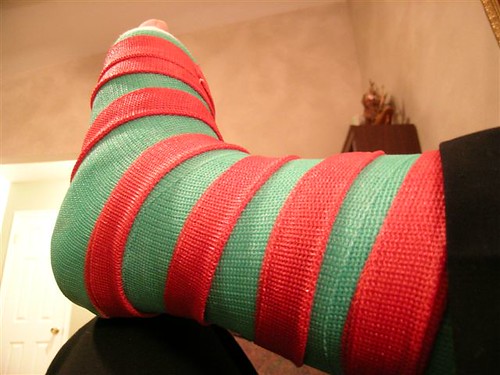 Thirteen advertising slogans for my new cast.
Thirteen advertising slogans for my new cast.1. Just in time for your holiday parties. It’s the latest in festive footwear.
2. Slimming! (Your other ankle never looked thinner.)
3. It’s a sympathy magnet!
4. Nothing says Merry Christmas like a smelly foot swaddled in gauze and fiberglass.
5. A great workout – like wearing a 10 pound ankle weight at all times.
6. Handy place to tuck your cash when you head out Christmas shopping.
7. Also serves as a portable foot sauna with convenient toe ventilation.
8. Great conversation piece – you’ll never tire of people teasing you to stop kicking your kids.
9. Comes with free Handicapped Parking permit*
*If you are able to get the proper form from your doctor and then drive (between the hours of 9-4) to the DMV office, park in a non-handicapped spot, hobble into building and stand/lean/balance on one foot in line to get it.
10. A great gift for that klutzy person in your life.
11. Also makes a perfect form-fitting stocking stuffer.
12. All this for only a $25. (Your copay may vary).
13. Available from MedCo™. The company that put the break in your Christmas break.
View More Thursday Thirteen Participants here
And because I’m dwelling on lameness and the healing process, my Christmas art for the day is from Murillo, Christ heals the paralytic at Bethesda.

Tuesday, December 12, 2006
Husbands
I have a husband. His name is Ken. I think I shall nominate him for sainthood soon. He deserves most of the credit for helping me survive this whole “as if my life weren’t complicated enough I think I should break a bone in just such a way as to make me practically immobile for a month” business. I may be using crutches, but it’s really Ken that I’m leaning on in many ways. Every night he gets home from work and commences his duties as father, mother, maid, and nursing home attendant. Never in the last 16 years have I been more proud of myself for tricking him into marrying me.
I had a dream last night that I had committed a horrible crime (in true Kafkaesque fashion, I didn’t know what I had done, just that it must have been bad). As I was being led away to prison, Ken was there, holding my hand and vowing that he still loved me and would come visit me every day. I awoke, relieved that I was still free (unless you count the plaster shackle around one leg) and touched by my husband’s unwavering loyalty.
When I told Ken about my dream, he said, “Sorry dear, but I wouldn’t come visit you every day. I’d be too busy with the kids. Maybe once every couple of weeks. Unless you really did commit the crime. Then I’d have to divorce you.”
Sigh. A hopeless romantic he is not.
And speaking of husbands taken for granted, let’s take a look at Joseph. In art, he is typically sidelined and cast as a clueless observer to the miraculous events of his step-son’s life. In an effort to protect the image of Mary’s virginity, Joseph often looks old enough to be her grandfather (in some apocryphal accounts he is said to be over 90).

In this Von Fuehrich painting, Joseph trails along behind the angelic parade. He’s likely muttering to himself: “Why is it always me who has to pick up after everybody?”

Where’sWaldo Joseph in this Rembrandt scene? Look for the workaholic carpenter busy in the shadows.

And here, Joseph takes a nap while Mary tends to the child. “Let me know if you need anything, honey” he offers, before nodding off, knowing full well that the parent without the mammary glands can only do so much for a crying baby.
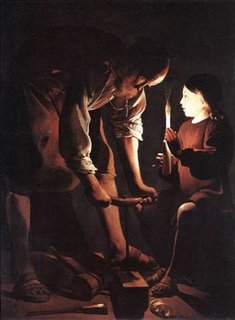
My favorite images of Joseph show him as a loving mentor. In this George de la Tour painting, Mary isn’t even in the room while Joseph trains his son in a bit of carpentry. The foreshadowing, as always, is there (the piercing of wood, the cross-shaped tool, the highlighting of Jesus’ palm by the candle) but for a moment, we see a tender scene of a loving father-figure and a boy with a look of admiration in his eyes. Joseph had a role to play, even if it wasn’t a starring one.
I had a dream last night that I had committed a horrible crime (in true Kafkaesque fashion, I didn’t know what I had done, just that it must have been bad). As I was being led away to prison, Ken was there, holding my hand and vowing that he still loved me and would come visit me every day. I awoke, relieved that I was still free (unless you count the plaster shackle around one leg) and touched by my husband’s unwavering loyalty.
When I told Ken about my dream, he said, “Sorry dear, but I wouldn’t come visit you every day. I’d be too busy with the kids. Maybe once every couple of weeks. Unless you really did commit the crime. Then I’d have to divorce you.”
Sigh. A hopeless romantic he is not.
And speaking of husbands taken for granted, let’s take a look at Joseph. In art, he is typically sidelined and cast as a clueless observer to the miraculous events of his step-son’s life. In an effort to protect the image of Mary’s virginity, Joseph often looks old enough to be her grandfather (in some apocryphal accounts he is said to be over 90).

In this Von Fuehrich painting, Joseph trails along behind the angelic parade. He’s likely muttering to himself: “Why is it always me who has to pick up after everybody?”

Where’s

And here, Joseph takes a nap while Mary tends to the child. “Let me know if you need anything, honey” he offers, before nodding off, knowing full well that the parent without the mammary glands can only do so much for a crying baby.

My favorite images of Joseph show him as a loving mentor. In this George de la Tour painting, Mary isn’t even in the room while Joseph trains his son in a bit of carpentry. The foreshadowing, as always, is there (the piercing of wood, the cross-shaped tool, the highlighting of Jesus’ palm by the candle) but for a moment, we see a tender scene of a loving father-figure and a boy with a look of admiration in his eyes. Joseph had a role to play, even if it wasn’t a starring one.
Monday, December 11, 2006
closets and windows
 My Christmas art for the day is one of my favorite Madonnas. It was painted in color by Roberto Ferruzzi, but I actually prefer the black and white copy I found several years ago in a book of Christian art. You may draw your own connections between the painting and the post that follows. Let’s just say I wanted to start with an image of a loving mother.
My Christmas art for the day is one of my favorite Madonnas. It was painted in color by Roberto Ferruzzi, but I actually prefer the black and white copy I found several years ago in a book of Christian art. You may draw your own connections between the painting and the post that follows. Let’s just say I wanted to start with an image of a loving mother.*Disclaimer* I reserve the right to be completely not-funny today. Even though I typically try to find humor in all things, occasionally I’m thinking about stuff that is just too serious to mock. So if you’re not in the mood to tolerate a bit of bleakness, please check back tomorrow when we will return to our regularly scheduled shallowness and attempts to amuse.
There’s an image from the news that has been haunting me this week. It is of a 10 year old girl named Shelby, beaten by her father and step-mother and locked into a linen closet. She is wedged between the shelves and the door, crying for help, covered in her own vomit. It is her darkest moment, but the evidence points to a long pattern of abuse – ten short years of pain and humiliation and the kind of confusion that must fill a child’s mind whose own parents seem to despise her. Shelby’s release from this torture came not from the opening of the closet door, but from her own death. In a strangely merciful way, she was freed from a life of pain by a different kind of escape.
I’ve been thinking about, or actually agonizing about Shelby and trying not to imagine her life, but imagining it anyway. It bothers me that we only know about Shelby because she died. I have to ask the obvious question: how many others are there, just like her, who live in “dark closets” of neglect and abuse? I am also deeply troubled by the single question of how Shelby’s parents could have possibly justified their actions. I’ve written about this before – the strange capacity humans have of lying to themselves and how it helps me understand atrocities such as the Amish school shooting. But that case involved victims unknown to the murderer. This case disturbs me even more because the very people who should have nurtured and protected this young life destroyed it.
In a recent article about Shelby’s death, a caseworker suggested that the roots to the abuse likely go back to the childhood of the abusers. "Something happened when [the step-mother] was supposed to be developing empathy as a child. It's like the Columbine High shooters. No feeling for others' suffering and humiliation." I’ve heard that in language acquisition there’s a linguistic “window of opportunity” – a time when we could learn to speak any language with perfect pronunciation, but only if we are exposed to it. When that window closes, if we haven’t learned to make certain sounds, we never will. I wonder if there’s a similar developmental phase for empathy. Perhaps the ability to empathize can be permanently precluded by neglect. And it’s easy to see how the abused, through enough exposure, can learn to speak the language of abuse instead.
Probably not coincidentally, I am also re-reading (for at least the fourth time) my parenting Bible, Unconditional Parenting by Alfie Kohn. Here’s what he says about empathy: “To step outside one’s own viewpoint, to consider how the world looks to another person, is, when you think about it, one of the most remarkable capabilities of the human mind.” Kohn says that a child naturally develops what he calls “perspective taking” when he starts to realize that other people’s lives are distinct from his own. Gabriel is just learning that when Grandma leaves our house, she continues to have things to do, places to go, emotions to feel. Children (and later adults) who can imagine how others experience the world are less likely to harm them. This is perhaps why Kafka once described war as a “monstrous failure of imagination.” To do violence to another person you must be incapable of imagining their perspective. You can only kill them if you see them as less human than yourself.
When I wrote last week about the qualities I admire in my kids, I was also thinking about Shelby and thinking that, ironically, the very traits we admire in children make them easily victimized. They are trusting, loving, dependent, and naïve to the dark truths of our world. I’m not sure if it was obvious, but as I made the list, I also meant to imply a connection between childlike and Christlike. And here’s where empathy fits in. Because there’s actually a difference between the “perspective taking” that Alfie Kohn describes and true empathy. The first means I can appreciate that someone else may be sad even though I am happy. The later means I actually feel that person’s sadness along with them. When I tell a sick friend “I really feel for you, man” I don’t actually mean that literally (unless the virus is very contagious in which case I’ll be feeling it soon enough). I believe true empathy must be pretty rare. And complete empathy has only been felt once – if you believe in a literal atonement – when Christ physically suffered for our sins, our pain, our emotional sorrows. Maybe the sympathy I feel for Shelby is meant to be just a shadow – a human vestige of a truly divine characteristic.
Saturday, December 09, 2006
Gold, frankincense and mirth

We've spent the last two days shopping but don't have much to show for it. I am not one of those organized people who has everything bought and wrapped by November 30th. I'm lucky to be done by Christmas eve. Why is it that every year I vow to do better but seem to still be picking up gifts until the very last minute?
I think the wise men had it easy. They never bothered to debate the age-appropriateness of gold. They probably didn’t compare the prices of frankincense at 3 or 4 different shops and then go back to the first place where they saw it only to find that it was sold out. And they were spared that whole advanced accounting act that parents with multiple children have to perform to make sure their spending is somewhat evenly distributed. In fact, the wise men only had one person on their whole Christmas list. Okay, so maybe they had to travel a bit to make their deliveries, but I’d prefer a little camel ride to the perilous prospect of Toys-R-Us on a Saturday night in December.
Maybe I should just keep it simple and get each of my kids one of these.

Friday, December 08, 2006
O (not so little) town of Bethlehem
If I’ve learned anything from Louis XIV, it’s that wearing high heels makes your ankles look slimmer. No, that wasn’t it. I was going to say that I learned from Louis to surround myself with people who treat me like royalty and make me look good. My sister in law Echo is just such a person. Not only did she make lasagna for my poor family this week (and bring a double batch to freeze for later) but she suggested I write about our family’s Belén tradition. What a great idea. If anything qualifies as a Christmas work of art, the family Belén does. I can take zero credit for the photographs (Echo’s), or the nicely organized website where they are displayed (Echo’s again), or the enormously artistic process of making the Belén pieces and setting it up every year (my mother and sister Teri). I did, however, take the lasagna out of the oven. I’m not totally worthless.

The beautiful insanity of the Belén began innocuously enough when my parents returned from a mission to Spain a few years ago. In Spain, they had seen families setting up Bethlehem villages in their homes using clay figurines. My parents collected a “starter” set of a few dozen pieces to bring home with them. Since then, the census taken each year in the “city of David” has revealed a burgeoning growth rate. From a small village set up against one wall, Bethlehem has expanded to a metropolis that fills the entire living room. Last year it included hundreds of people and buildings, a complex topography that blended into the rock fireplace, and a waterway complete with a Galilean fishing boat and crew.
If you think that thecrazy creative people responsible for this amazing production probably don’t sleep for much of the month of December, you’re exactly right. My mother and sister Teri pretty much allow this project to consume their lives for several weeks, for which those of us slugs who just get to enjoy it when it’s done are indeed grateful. Many friends, neighbors, and total strangers lured by the legend come to see the Belén every year. Its finest hour, however, is on Christmas eve when the kids and grandkids crowd into what space is left in the living room and watch as my mother shines a flashlight onto the various locations while my dad reads the scriptural account of Jesus’ birth.
Sadly, because of a huge flood in the basement (and subsequent ill packing job by the disaster recovery flunkies) Teri and Mom have decided to keep their sanity this year and keep the whole thing in storage. It’s tragic, but I suspect we will all survive and be even more grateful to visit Bethlehem next year.

The beautiful insanity of the Belén began innocuously enough when my parents returned from a mission to Spain a few years ago. In Spain, they had seen families setting up Bethlehem villages in their homes using clay figurines. My parents collected a “starter” set of a few dozen pieces to bring home with them. Since then, the census taken each year in the “city of David” has revealed a burgeoning growth rate. From a small village set up against one wall, Bethlehem has expanded to a metropolis that fills the entire living room. Last year it included hundreds of people and buildings, a complex topography that blended into the rock fireplace, and a waterway complete with a Galilean fishing boat and crew.
If you think that the
Sadly, because of a huge flood in the basement (and subsequent ill packing job by the disaster recovery flunkies) Teri and Mom have decided to keep their sanity this year and keep the whole thing in storage. It’s tragic, but I suspect we will all survive and be even more grateful to visit Bethlehem next year.
Thursday, December 07, 2006
A bird in hand
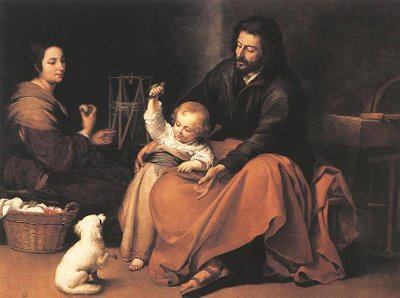
Today’s painting is The Holy Family with a Little Bird by Murillo. At fist glance, it may seem that Jesus is doing the “boys will be boys” thing and teasing the dog by holding the bird above his head. But in fact – as with most paintings of Jesus as a child – the scene is meant to foreshadow the atonement. The bird is a symbol of the soul, and Jesus is saving it from destruction.
I love Murillo’s depiction of Christ. With his smiling, angelic face and the way he leans back into the arms of Joseph, he embodies the pure joy of life and trusting nature that I see often in my own children but rarely in myself. This need for childlike qualities – something I’ve been thinking about a lot lately – is the topic of my Thursday Thirteen list.
13 traits I admire in my children
1. Candidness
“Mom, I hope you’re not offended but this casserole is super gross.”
2. Generosity
My kids share everything with me: their Halloween candy, the last donut in the box, their colds, their secrets, their big plans for the future, their favorite Calvin and Hobbes lines, and their infectious love of life.
3. An easily triggered sense of humor
It takes some earth-shatteringly funny überwit to make me laugh out loud in a movie. My kids? Give them some fart jokes and a sarcastic koala with a British accent and they’re watching cinematic gold. I really need to lighten up. I’d probably enjoy movies more. And my kids more. And their farts too.
4. Keen vision
“Hey, why is my Your-life-is-not-complete-until-you-buy-these-new-Lego-sets! catalog buried under piles of newspapers and rolled up and tucked inside a cereal box at the bottom of the garbage?”
5. Imagination
In an effort to make their own mundane lives a bit more radioactive, my boys can turn a meal of green beans and lasagna into “spent fuel rods” and “Chernobyl wreckage.” If Ethan is holding Nora when she spits up, I get to hear this: “BOOP! BOOP! Warning, Warning. Toxic spill detected. Activate containment cloths.”
6. Quickness to forgive
As much as I try not to hold grudges, I can still remember offensive remarks long after their sting should have worn off. My kids on the other hand are happy to forgive and forget. (Which is a good thing for me since it’s often me doing the apologizing.)
7. Empathy
One day McKay started crying while reading a Harry Potter book. He was a little embarrassed, but he finally admitted that he felt sorry for Hagrid. Aw, how sweet. I think this kind of unconditional empathy (even for big hairy fictional characters) is one the first things to go when we “grow up”.
8. Trusting nature
My sons actually believe everything they read on cereal boxes. “Mom! Look, it says I get 100% of all these vitamins when I eat this. I could just have cereal for every meal.”
9. And not coincidentally, trustworthiness
In a world run by children, your cub-scout promise would be your bond.
 10. Attunement to the supernatural
10. Attunement to the supernaturalThese may look like you everyday run-of-the-mill wadded up baby wipes, but to Gabriel, they are genuine angel brains.
11. Scientific inquisitiveness
Actual lab notes to Nora’s recent experiments: “What will happen if I drop this spoon onto the floor?.....What will happen if I do it again?.....and again?.....and again?....and again?”
12. Flexibility (figurative)
My kids can fall asleep in their beds, or in the van, or in a tent, or in a trailer, or in a boat, or at Grandma’s house, or with a mouse, or in the rain, or on a train…
13. Flexibility (literal)
Mmmmmm. Toes.

View More Thursday Thirteen Participants here
Tuesday, December 05, 2006
Art from the crypt
There is a secret labyrinth under the art museum on my university campus. Below the public basement hides a second basement so hush-hush that it isn’t even numbered on the elevator buttons. It can only be accessed by museum curators with heavy keys and entry codes and occasionally by a professor who is willing to swear an oath of secrecy and relinquish a blood sample. On my first trip to the crypt I put on a pair of white gloves and handled dozens of original artworks by Albrecht Dürer, Rembrandt and Gustave Dore. I’m not sure, but I think I held my breath for 90 minutes straight.
One work I saw that day was an etching by Rembrandt: The Adoration of the Shepherds by Lamplight. It’s a case where (to me anyway) a small print made of black ink on white paper can carry more meaning than a wall full of colorful oil paintings. It seemed especially fitting to me that a scene of the infant Jesus could be so simple yet so powerful at the same time.
 An etching is made by cutting into a wax-covered copper plate, immersing the plate in acid, and then applying ink to make prints from the resulting carved surface. Because of this process, the darkest areas in Rembrandt’s print – the shepherds, the oxen and the shadows around them – were actually given the most attention by the artist. The lightest areas – where Jesus and Mary rest beneath a lamp-lit archway – required the least amount of detail. In fact, Rembrandt depicted the entire body and face of Jesus with just a handful of lines.
An etching is made by cutting into a wax-covered copper plate, immersing the plate in acid, and then applying ink to make prints from the resulting carved surface. Because of this process, the darkest areas in Rembrandt’s print – the shepherds, the oxen and the shadows around them – were actually given the most attention by the artist. The lightest areas – where Jesus and Mary rest beneath a lamp-lit archway – required the least amount of detail. In fact, Rembrandt depicted the entire body and face of Jesus with just a handful of lines.
The result is that the center of the etching seems to glow, not from the light of the lamp on the wall, but from the tiny baby himself. All around him, busy tangles of cross-hatched lines define the hay, the faces of the animals, and the shepherd’s hats, but the plain figure of Jesus draws our focus. He is pure and uncomplicated. To me, Rembrandt’s genius rests not in his flashy realism or sophisticated portraits, but in the way he could – by making a few subtle cuts into wax – give new meaning to the humility of the savior’s birth.
One work I saw that day was an etching by Rembrandt: The Adoration of the Shepherds by Lamplight. It’s a case where (to me anyway) a small print made of black ink on white paper can carry more meaning than a wall full of colorful oil paintings. It seemed especially fitting to me that a scene of the infant Jesus could be so simple yet so powerful at the same time.
 An etching is made by cutting into a wax-covered copper plate, immersing the plate in acid, and then applying ink to make prints from the resulting carved surface. Because of this process, the darkest areas in Rembrandt’s print – the shepherds, the oxen and the shadows around them – were actually given the most attention by the artist. The lightest areas – where Jesus and Mary rest beneath a lamp-lit archway – required the least amount of detail. In fact, Rembrandt depicted the entire body and face of Jesus with just a handful of lines.
An etching is made by cutting into a wax-covered copper plate, immersing the plate in acid, and then applying ink to make prints from the resulting carved surface. Because of this process, the darkest areas in Rembrandt’s print – the shepherds, the oxen and the shadows around them – were actually given the most attention by the artist. The lightest areas – where Jesus and Mary rest beneath a lamp-lit archway – required the least amount of detail. In fact, Rembrandt depicted the entire body and face of Jesus with just a handful of lines. The result is that the center of the etching seems to glow, not from the light of the lamp on the wall, but from the tiny baby himself. All around him, busy tangles of cross-hatched lines define the hay, the faces of the animals, and the shepherd’s hats, but the plain figure of Jesus draws our focus. He is pure and uncomplicated. To me, Rembrandt’s genius rests not in his flashy realism or sophisticated portraits, but in the way he could – by making a few subtle cuts into wax – give new meaning to the humility of the savior’s birth.
Monday, December 04, 2006
Christmas wrappings
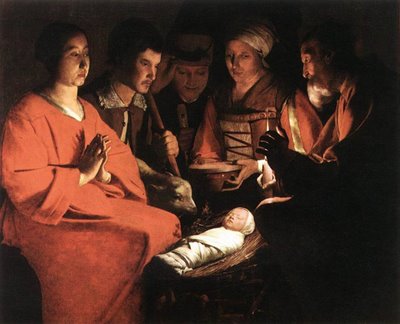
"And so it was, that, while they were there, the days were accomplished that she should be delivered. And she brought forth her firstborn son, and wrapped him in swaddling clothes and laid him in a manger; because there was no room for them in the inn."
Georges de la Tour, in addition to giving us a rare exception to the rule that Mary always wears blue, shows us exactly what a swaddled baby Jesus would have looked like. De la Tour would know, since in France swaddling was still customary well into the 19th century when Rousseau wrote this about it:
"The child has hardly left the mother's womb, it has hardly begun to move and stretch its limbs, when it is given new bonds. It is wrapped in swaddling bands, laid down with its head fixed, its legs stretched out, and its arms by its sides; it is wound round with linen and bandages of all sorts so that it cannot move.”Rousseau was criticizing the practice of swaddling by lazy French mothers who didn’t want to deal with their children so they would wrap them up and leave them unattended, or better yet, hang them by their swaddling bands to a post on the wall. It’s a good thing modern parenting has eliminated this kind of barbarity.
In Jewish custom, swaddling clothes consisted of fabric cut into long thin bands (the term swaddling comes from swath – the width covered by the single cut of a scythe). The bands would be wrapped around a newborn in order to comfort them and give them proper posture. Sometimes the band would first be worn as a girdle around the belly of the pregnant woman, then used to swaddle the child, then saved for the eventual purpose of wrapping the body for burial. Paintings of Christ as a swaddled infant tend to foreshadow his death by showing him sleeping in a kind of haunting stillness. We are meant to see the relationship between the child “wrapped in swaddling clothes and laid in a manger" with the body of Jesus "wrapped in linen, laid in a sepulcher that was hewn in stone."
The next time you are in Aachen, Germany, you can visit the reliquary said to hold the original swaddling clothes of Jesus. The relic is a brownish folded piece of fabric. But you can only see it if your visit coincides with its exposure – once every 7 years for 14 days. So you’d better mark your calendars now for June 2007.
When our children were born (all in the same hospital) (not all at the same time) (or was that obvious?) the nurses would do this tricky blanket wrapping job each time they had temporary possession of the baby. I’d let the nurses take a turn while I ate lunch, and when they returned, they’d hand me a tiny mummy with a face. One nurse told me that every hospital has a different swaddling protocol, and nurses that work at more than one hospital have to know them all. I’ll bet they went to special infant-wrapping camps just for training purposes. But it was all a waste as far as I was concerned, because as soon as the nurses left the room I would unwrap my babies. How else was I supposed to admire their toes?
Sunday, December 03, 2006
My dose of irony for the day

Not that I wouldn't want to be in Rio de Janeiro right now, but doesn't it seem a bit ironic that they are celebrating Christmas with a 27 story, 450 ton tree covered with 2.8 million light bulbs? That's quite a birthday candle for a child born in a stable.

Saturday, December 02, 2006
Mass confusion
 Today’s choice for my Christmas Art Advent Blog comes from my favorite Spanish artist Bartolomé Esteban Murillo. The Virgin Mary, the beaded rosary she holds, and Murillo all remind me of my experiences in Spain. So I think I’ll tell my story of how a little Mormon girl from Utah once became an honorary Spanish Catholic.
Today’s choice for my Christmas Art Advent Blog comes from my favorite Spanish artist Bartolomé Esteban Murillo. The Virgin Mary, the beaded rosary she holds, and Murillo all remind me of my experiences in Spain. So I think I’ll tell my story of how a little Mormon girl from Utah once became an honorary Spanish Catholic.When I was 8 years old, my family lived for several months in Spain while my father directed a Study Abroad program. In a highly effective language learning method called “throw the kid in the pool and they’ll figure out how to swim soon enough,” my parents enrolled me in a Spanish school even though I spoke nary a word of the language. The school was a private Catholic academy, as I believe were most schools in Madrid at the time. It felt like pretty much everything and everyone in Spain was Catholic. Except me.
On my first day at school, I was introduced to my classmates (who no doubt saw me as some kind of alien because not only did I have blonde hair and blue eyes but my name was inexplicably not Maria de la something or other.) Within a few minutes of my arrival, we were all being led out of the school complex and down the street to the nearest cathedral. The girls around me were all somber and a few were fingering the crosses around their necks and whispering. We went into the church – a cold stone building that smelled like my grandpa’s basement mixed with a new pungency I would later recognize as incense. An enormous painting of Christ’s body on the cross loomed above me on the wall. A robed priest at the front began chanting in a foreign language (Spanish? Latin? it could have been Botswanan for all I knew). At certain intervals, the students and teachers would respond to his questions with memorized replies and gestures in the air. I sat while they stood and stood when they kneeled. I was completely mystified, which isn’t a bad state to be in for spiritual purposes, but compared to the morning rituals I knew from my school back home – the Pledge of Allegiance and listening to the day’s lunch menu on the intercom – the whole thing was somewhat terrifying. So needless to say, I wasn't exactly thinking spiritual thoughts – not unless you count the holy in "Holy cow! Are we going to have to do this every single day?"
As it turned out, I had just happened to start school on a day when the entire student body was attending a funeral mass for a classmate who had fallen to her death from a school wall the week before. For the rest of my time there, aside from a few morning catechisms in the classroom, the school was not that different from what I was used to. I learned to swim very quickly. I learned the language and I learned to kiss my friends on both cheeks and I learned a hundred songs to sing while playing the Spanish version of Chinese jumprope in the courtyard. And after a few weeks, I knew every Catholic catechism by heart and would proudly recite them to my parents. It was a sign of their unshakable personal faith and love of the Spanish culture that my parents listened to their little blonde daughter saying Hail Marys and smiled proudly.
Friday, December 01, 2006
baby steps
In the spirit of the season and out of a personal desire to focus a little more on the Christ in Christmas, I have decided to try something new this month. I plan to include a different painting of Christ each day as a kind of “Advent Blog.” The history of art is filled with fascinating religious works – works I don’t want to neglect out of fear of offending someone. So whether you share my faith or not, I hope you’ll find in each post something interesting, or something entertaining, or something to think about. All good art should have the power to do these things, regardless of your personal beliefs.
Of course I’m still going to talk about myself. Because that’s why I have a blog.
I went to the doctor yesterday with the delusional assumption that I’d be getting a walking boot for my foot so my life could return to normal. To continue a metaphor I’m growing rather fond of, I could get back to piloting the Death Star II on its way to destroying unsuspecting planets. Alas, those Rebel forces are relentless and the news was not good. I actually have two different fractures and the more vulnerable one is widening. If I don’t stay completely off my foot for at least 3 (!) weeks, I risk needing surgery. My scream of anguish from the Pit of Despair took the doctor by surprise. She asked: “Do you have a job or something?” “Yeah, well, something like that.” I sighed while scanning desperately around the room for sharp implements with which to impale myself.
So needless to say, I’ve been thinking about walking lately. I’ve been thinking about how much I miss it. As the great existentialist philosopher Joni Mitchell said: “Don’t it always seem to go that you don’t know what you’ve got till it’s gone.” Walking is something I’ve done quite unconsciously since the age of one. It’s my God-given right as a member of the bipedal species to put one foot in front of the other without giving it too much thought. Now – because it’s such a pain to get from point A to point B – I find myself thinking things like: “how much do I really want that glass of water” and also “empty bladders are overrated.”
Walking has served as a metaphor for many things in religious art and in the scriptures. Those who “walk with God” live righteously. Walking is equated with obedience (Lev 26:3), humility (Micah 6:8), and love (Eph 5:2). The whole experience of mortality is a “walk through the valley of the shadow of death” (Psalm 23). And in his covenant with Israel, the Lord says “I will walk among you and will be your God” (Lev 26:12).
 I recently discovered a pair of Heironymous Bosch paintings that make me see this last verse literally as well as metaphorically. The first is a very unusual scene of Christ as a baby, learning to walk with the help of a wooden frame. He holds a toy whirligig in one hand and with the other, he pushes the frame as he takes a single step forward.
I recently discovered a pair of Heironymous Bosch paintings that make me see this last verse literally as well as metaphorically. The first is a very unusual scene of Christ as a baby, learning to walk with the help of a wooden frame. He holds a toy whirligig in one hand and with the other, he pushes the frame as he takes a single step forward.
 The companion piece to this painting – found on the front side of the same wooden panel – shows Christ walking up the hill to Calvary. The parallels are deliberate and obvious: the whirligig and the cross cut across both scenes at exactly the same angle, and under the weight of the cross, Christ steps with the left foot and bends the right knee and ankle behind him, almost as if completing the series of steps begun more than 30 years before. From vulnerable child to willing martyr, he walked a single path. To me, these images give new meaning to the song running through my head today:
The companion piece to this painting – found on the front side of the same wooden panel – shows Christ walking up the hill to Calvary. The parallels are deliberate and obvious: the whirligig and the cross cut across both scenes at exactly the same angle, and under the weight of the cross, Christ steps with the left foot and bends the right knee and ankle behind him, almost as if completing the series of steps begun more than 30 years before. From vulnerable child to willing martyr, he walked a single path. To me, these images give new meaning to the song running through my head today:
Of course I’m still going to talk about myself. Because that’s why I have a blog.
I went to the doctor yesterday with the delusional assumption that I’d be getting a walking boot for my foot so my life could return to normal. To continue a metaphor I’m growing rather fond of, I could get back to piloting the Death Star II on its way to destroying unsuspecting planets. Alas, those Rebel forces are relentless and the news was not good. I actually have two different fractures and the more vulnerable one is widening. If I don’t stay completely off my foot for at least 3 (!) weeks, I risk needing surgery. My scream of anguish from the Pit of Despair took the doctor by surprise. She asked: “Do you have a job or something?” “Yeah, well, something like that.” I sighed while scanning desperately around the room for sharp implements with which to impale myself.
So needless to say, I’ve been thinking about walking lately. I’ve been thinking about how much I miss it. As the great existentialist philosopher Joni Mitchell said: “Don’t it always seem to go that you don’t know what you’ve got till it’s gone.” Walking is something I’ve done quite unconsciously since the age of one. It’s my God-given right as a member of the bipedal species to put one foot in front of the other without giving it too much thought. Now – because it’s such a pain to get from point A to point B – I find myself thinking things like: “how much do I really want that glass of water” and also “empty bladders are overrated.”
Walking has served as a metaphor for many things in religious art and in the scriptures. Those who “walk with God” live righteously. Walking is equated with obedience (Lev 26:3), humility (Micah 6:8), and love (Eph 5:2). The whole experience of mortality is a “walk through the valley of the shadow of death” (Psalm 23). And in his covenant with Israel, the Lord says “I will walk among you and will be your God” (Lev 26:12).
 I recently discovered a pair of Heironymous Bosch paintings that make me see this last verse literally as well as metaphorically. The first is a very unusual scene of Christ as a baby, learning to walk with the help of a wooden frame. He holds a toy whirligig in one hand and with the other, he pushes the frame as he takes a single step forward.
I recently discovered a pair of Heironymous Bosch paintings that make me see this last verse literally as well as metaphorically. The first is a very unusual scene of Christ as a baby, learning to walk with the help of a wooden frame. He holds a toy whirligig in one hand and with the other, he pushes the frame as he takes a single step forward.  The companion piece to this painting – found on the front side of the same wooden panel – shows Christ walking up the hill to Calvary. The parallels are deliberate and obvious: the whirligig and the cross cut across both scenes at exactly the same angle, and under the weight of the cross, Christ steps with the left foot and bends the right knee and ankle behind him, almost as if completing the series of steps begun more than 30 years before. From vulnerable child to willing martyr, he walked a single path. To me, these images give new meaning to the song running through my head today:
The companion piece to this painting – found on the front side of the same wooden panel – shows Christ walking up the hill to Calvary. The parallels are deliberate and obvious: the whirligig and the cross cut across both scenes at exactly the same angle, and under the weight of the cross, Christ steps with the left foot and bends the right knee and ankle behind him, almost as if completing the series of steps begun more than 30 years before. From vulnerable child to willing martyr, he walked a single path. To me, these images give new meaning to the song running through my head today:I'll Walk with God from this day on.I think it's time to rent a copy of The Student Prince again. Is anybody willing to drive me to the video store? In the meantime, I'll have to content myself with this touching, synthesized organ version.
His helping hand I'll lean upon.
This is my prayer, my humble plea,
May the Lord be ever with me.
There is no death, tho' eyes grow dim.
There is no fear when I'm near to Him.
I'll lean on Him forever
And He'll forsake me never.
He will not fail me
As long as my faith is strong,
Whatever road I may walk along.
I'll Walk with God, I'll take His hand.
I'll talk with God, He'll understand.
I'll pray to Him, each day to Him
And He'll hear the words that I say.
His hand will guide my throne and rod
And I'll never walk alone
While I walk with God.
Thursday, November 30, 2006
13 things that put the Q. in Quirky
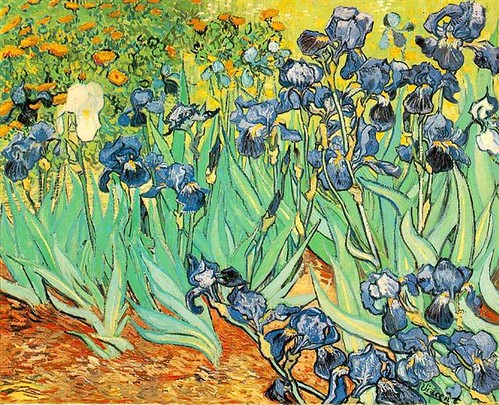
No self-respecting art blog would be complete without a copy of Vincent Van Gogh’s Irises. I’ve always seen the single white iris as a self-portrait of the artist – a lonely man, alienated by his genius and mental illness. But his uniqueness also made him beautiful and made his artistic vision of the world priceless. I think that kind of individuality is worth emulating.
So today’s Thursday Thirteen – in honor of Vincent – lists 9 ways I have tried to stand out from the crowd plus 4 ways that my kids are carrying on the tradition.
1. I often sign my name “Julie Q.” This started when I was young and I felt deprived by my parents’ politically incorrect tradition of giving their daughters no middle names because they would get them when they got married. (Ask my 2 unmarried sisters how much they love this tradition.)
2. For a few years growing up, I also eliminated the “e” from the end of my name because there were far too many other Julies around. I confess, I occasionally even dotted the i with a cute circle that (in retrospect) was a little too large for common decency. I strongly deny any vicious rumors that I ever made the dot into a heart.
3. I have no white walls in my home. We’ve got yellow, two shades of green, a kind of pinkish-brown speckle, a paint color called “camel-spit,” and in the boys’ room sky-blue with clouds and green hills with a huge freight train that runs across the base of three walls. I’m sure if we ever tried to sell this house, the realtor would walk through and shake her head, “Good grief woman, have you never heard of neutrals?” But I like it this way. Color makes me happy.
4. I grew up in a family of polyglots which literally means many tongues but thankfully here means speakers of many languages. We sing “O Tanenbaum” in German, “I am a Child of God” in Chinese, “Un elefante” in Spanish, and an odd little song in Guaraní called “Wasington,” which we chant while passing rolled up socks around in a circle. I’m assuming this is somewhat unique, but you never know.
5. I have a blog. I named it something strange enough that I have to put a glossary in my sidebar.
6. At my Junior High, it was the height of coolness to own an Izod™ shirt. To be authentic, these shirts had to have an official Izod insignia alligator on the left side and be purchased in the mall at Copper Rivet for the exorbitant price of $12. Just to be different (and perhaps also because I couldn’t afford to keep up with the trend), I found a knit material with tiny, bright pink alligators all over it and made my own shirt. My motto: “If you can’t join ‘em, outsew ‘em.”
7. Our family celebrates Groundhog day. Every year on February 2, my husband and the kids and I watch the movie Groundhog Day and wax nostalgic about our visit to Punxsutawney, PA. I’ve suggested many times that GD should be a national holiday, but for some reason my bill never makes it out of the Senate committee hearings. Darn those politicians.
8. My all-time favorite movie – Sense and Sensibility – isn’t all that unusual since lots of people like Jane Austen. But my 2nd favorite movie is Harold and Maude – a dark comedy made in 1971 about a young man who drives a hearse, stages suicides to get his mother’s attention and falls in love with an 79 year-old flower child. Weird enough? My friend Tara and I have hosted a couple of Harold and Maude parties where we served food from the movie and decorated the place with sunflowers. And cleavers. And a severed arm. (You need to see this movie).
9. During each of the past few years we have homeschooled our kids in one form or another. This means we stand out from our neighbors. But we also do a kind of dual enrollment arrangement where the kids attend public school for part of the day. This means we stand out from our homeschool friends, who see us as less than fully converted to the cause. Maybe I just have a hard time making up my mind. Or maybe not. I’ll have to think about that one.
+ 1. You thought I was joking when I said that Ethan once wanted to be Hoover Dam for Halloween? We take the creative costume thing very seriously.
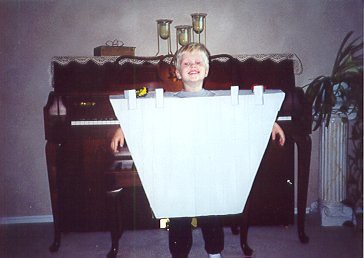
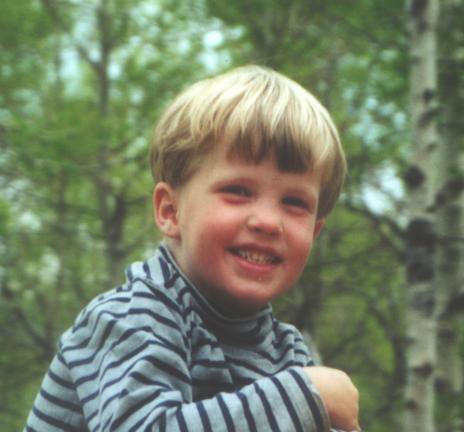
+ 2. McKay went through a phase where he insisted on wearing turtlenecks every day. For an entire year. Fall, winter, spring and summer. We humored him on his one and I bought a whole bunch of turtlenecks because he was the middle child and needed a way to assert his independence. When I’m looking through old family photos I can always date the ones from that year by what McKay is wearing.
+ 3. My 5 year old son Gabriel has more quirkiness in his little finger than I have in my whole body. The other night at dinner he befriended his biscuit and refused to eat little “Indoors,” and instead made him a bed in a Tupperware container. Gabie then made us put Indoors up on top of the fridge out of harm’s way. This was because the last time we had biscuits, Gabriel also made a new friend who sadly met his demise when a bouncy ball knocked him from the counter to the floor where he crumbled, as biscuits and sometimes friendships do.
+ 4. Admittedly it’s difficult for a 6-month old baby to distinguish herself. But so far Nora has shown an amazing aptitude at making dolphin noises. I don’t speak dolphin so I’m not sure if her vocabulary is particularly eloquent or not. But I suspect she’s going to be a poet. Either that or a yoga instructor.
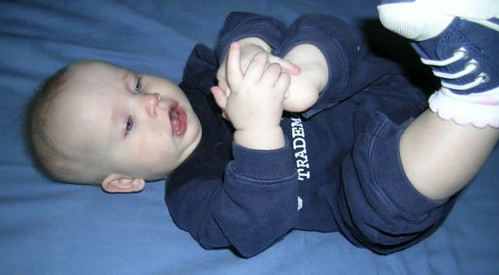
Well that's my list, but I have one more side note. It makes me sad when on the first day of a new semester I ask my students to tell me something unusual about themselves and a few say they can’t think of anything. I’m hoping this is just because they go blank under pressure, not because they don’t feel unique. I think everyone needs to be quirky in some way or another.
Monday, November 27, 2006
The foot bone’s connected to the whine bone
Random musings from broken foot land…
When I first hurt my foot I was pretty sure it was broken. First clue: the loud crack I heard as I fell. I’m lying on the ground looking up at the garage ceiling thinking “Huh. That didn’t sound so good.” So then I drag myself into the house and start crawling around trying to decide what to do. Gabriel, who can tell something is wrong (since his mom doesn’t crawl around on her hands and knees very often), offers to get me the preschoolers’ panacea – a bandaid. When I tell him “No thanks kiddo, I think it might be something a bandaid can’t fix.” He shrugs and says, “Well then can I ride on your back like a horsie?”
I have proven the adage that “even when all your kids are grown, you never get to retire from being a parent.” When I decided to go to the doctor and my husband was still stuck at work, who did I call? My Mommy and Daddy. They swooped in to rescue me. Dad drove and stayed with me for two hours at the InstaCare (a misnomer if ever there was one). My mom stayed at my house with the kids and disobeyed my strict instructions to not clean anything and did the dishes and swept the floor while I was gone. My parents are awesome.
The doctor looked no older than 16 and really did nothing to earn what I’m sure was a huge “day after Thanksgiving wish I were golfing but am stuck at an after-hours clinic” fee. All Doogie Howser did was squeeze my foot in various places and ask if it hurt. I take it back, he did have to apply that tricky Medical School Lesson #1674: yelp of pain = injured spot. The real diagnosis came from the x-ray lab technician, and the actual splinting of the foot was done by the medical assistant with the lowest degree. Heck, I could have saved them all that trouble and just gone with my mother’s verdict. When she first arrived, she took one look at the odd protrusion on the side of my foot and said “You broke your fifth metatarsal.” She knew this because she had broken the same bone many years before. But she was tripping up the steps from her garage not down them so don’t go suggesting “like mother like daughter.”
I had no idea my universe was so 5th-metatarsal-centric. Suddenly I feel completely helpless. I can hobble around on crutches but I can’t carry anything – not even my baby. So I have to boss my husband and kids around (even more than usual) and tell them to “fetch this” and “go get me that.” Ethan has requested an increase in his slave wages. I’m even calling in favors from neighbors since I can’t drive. I never realized my life was so precariously balanced on the pinpoint of my own agility. To mix metaphors, I was like an Imperial crewmember on the Death Star, oblivious to the fact that one well-placed torpedo could cause the whole shebang to self destruct.
I am getting tired of telling people that I broke my foot making bread. And they don’t believe me when I say “The Olympic speed skating trials didn’t go too well.” So I’m taking nominations for a new explanation. Any suggestions?
When I first hurt my foot I was pretty sure it was broken. First clue: the loud crack I heard as I fell. I’m lying on the ground looking up at the garage ceiling thinking “Huh. That didn’t sound so good.” So then I drag myself into the house and start crawling around trying to decide what to do. Gabriel, who can tell something is wrong (since his mom doesn’t crawl around on her hands and knees very often), offers to get me the preschoolers’ panacea – a bandaid. When I tell him “No thanks kiddo, I think it might be something a bandaid can’t fix.” He shrugs and says, “Well then can I ride on your back like a horsie?”
I have proven the adage that “even when all your kids are grown, you never get to retire from being a parent.” When I decided to go to the doctor and my husband was still stuck at work, who did I call? My Mommy and Daddy. They swooped in to rescue me. Dad drove and stayed with me for two hours at the InstaCare (a misnomer if ever there was one). My mom stayed at my house with the kids and disobeyed my strict instructions to not clean anything and did the dishes and swept the floor while I was gone. My parents are awesome.
The doctor looked no older than 16 and really did nothing to earn what I’m sure was a huge “day after Thanksgiving wish I were golfing but am stuck at an after-hours clinic” fee. All Doogie Howser did was squeeze my foot in various places and ask if it hurt. I take it back, he did have to apply that tricky Medical School Lesson #1674: yelp of pain = injured spot. The real diagnosis came from the x-ray lab technician, and the actual splinting of the foot was done by the medical assistant with the lowest degree. Heck, I could have saved them all that trouble and just gone with my mother’s verdict. When she first arrived, she took one look at the odd protrusion on the side of my foot and said “You broke your fifth metatarsal.” She knew this because she had broken the same bone many years before. But she was tripping up the steps from her garage not down them so don’t go suggesting “like mother like daughter.”
I had no idea my universe was so 5th-metatarsal-centric. Suddenly I feel completely helpless. I can hobble around on crutches but I can’t carry anything – not even my baby. So I have to boss my husband and kids around (even more than usual) and tell them to “fetch this” and “go get me that.” Ethan has requested an increase in his slave wages. I’m even calling in favors from neighbors since I can’t drive. I never realized my life was so precariously balanced on the pinpoint of my own agility. To mix metaphors, I was like an Imperial crewmember on the Death Star, oblivious to the fact that one well-placed torpedo could cause the whole shebang to self destruct.
I am getting tired of telling people that I broke my foot making bread. And they don’t believe me when I say “The Olympic speed skating trials didn’t go too well.” So I’m taking nominations for a new explanation. Any suggestions?
Saturday, November 25, 2006
Very black Friday
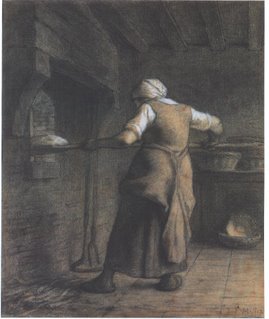 Seeing as how November is National Family Bread Baking Month and all, yesterday I finally gave in to the tremendous peer pressure and got around to making some whole wheat bread. Baking some "staff of life" always makes me feel ultra domestic and transports me to the 19th century. Well, almost.
Seeing as how November is National Family Bread Baking Month and all, yesterday I finally gave in to the tremendous peer pressure and got around to making some whole wheat bread. Baking some "staff of life" always makes me feel ultra domestic and transports me to the 19th century. Well, almost.In Millet’s homey charcoal drawing of a peasant woman baking bread, he used all earth tones to show her closeness to nature. With sleeves rolled up, her hair wrapped, and shoulders stooped, she focuses on the activity that will save her family from starvation. I’m sure my bread making process was much like hers…..with a few minor exceptions:
Millet’s 19th century peasant woman did not have packaged dry yeast, or powdered lecithin from the health food store. Or canola oil in a bottle. Or honey in a plastic bear. Or fine grained salt. Or warm water from the tap. (Yes, that pretty much covers every single ingredient).
She had to fire up her own oven and work some kind of serious peasant magic to figure out the right temperature. I had to push a few buttons.
I can almost guarantee that she didn’t have an electric wheat grinder in her garage.
I am positive that if she did have a wheat grinder in her garage, she wouldn’t have slipped on the concrete steps on her way out and fractured her foot.
Clearly 21st century bread making is a far more hazardous activity. From now on I shall leave it to the professionals.
Friday, November 24, 2006
Introductions
Today’s post is dedicated to my cool brother Steve, who is way funnier than I am and has his own blog but is too busy running his company to update it. He was also my first reader and still checks my blog daily so everybody say hello to Steve *wave*. It was also Steve who gave me a gallery guide from the Goya section of the Prado Museum – a guide that has proven to be unexpectedly useful today.
So 2006 was an on year for Thanksgiving which means the relatives from my father’s side reuned from far and near to Price, Utah for some feasting, mingling and hoop shooting. We made a big enough group to fill the gymnasium of the church reserved by Aunt Weezer for the occasion. After the consumption of much traditional Thanksgiving fare, we constructed a huge folding-chair circle and commenced the family introductions. Ethel and Elton (aren’t those the greatest grandparent names ever?) had only four children so that part is easy. And I know all their grandchildren (my cousins) because we grew up together. But I get completely lost when we get to the greats and the great greats who seem to be multiplying at exponential rates. Thus the need for introductions.
Each family took a turn introducing their kids and giving a short update of the year’s accomplishments. After one cousin shared a bit too much embarrassing personal information about her grown daughter’s recent weight loss (40 inches, JumpSnap Diet, going to be on an infomercial for being a big loser, “hello? Mom please sit down!”) my brother Steve suggested we start working on Dad’s family-intro. spiel for next time.
We could have gone on, but that’s where the tryptophan wore off and a massive game of speed basketball began. Oh well. We have a full two years to perfect it.

Speaking of less-than-flattering family portraits, here’s one from Francisco Goya of the Royal Family of Charles IV. Or as one writer described it “the corner baker and his wife after winning the lottery.” Perhaps Charles’ own family intro. spiel would have gone something like this:
Do you think they played hoops in the royal gymnasium afterwards?
So 2006 was an on year for Thanksgiving which means the relatives from my father’s side reuned from far and near to Price, Utah for some feasting, mingling and hoop shooting. We made a big enough group to fill the gymnasium of the church reserved by Aunt Weezer for the occasion. After the consumption of much traditional Thanksgiving fare, we constructed a huge folding-chair circle and commenced the family introductions. Ethel and Elton (aren’t those the greatest grandparent names ever?) had only four children so that part is easy. And I know all their grandchildren (my cousins) because we grew up together. But I get completely lost when we get to the greats and the great greats who seem to be multiplying at exponential rates. Thus the need for introductions.
Each family took a turn introducing their kids and giving a short update of the year’s accomplishments. After one cousin shared a bit too much embarrassing personal information about her grown daughter’s recent weight loss (40 inches, JumpSnap Diet, going to be on an infomercial for being a big loser, “hello? Mom please sit down!”) my brother Steve suggested we start working on Dad’s family-intro. spiel for next time.
“We’ve had a busy year. My oldest son Jim couldn’t be here but sends his regards from the al-Qaeda training caves. My #2 son Scott is here, thanks to his parole officer extending the radius of his ankle-bracelet range. Speaking of parole, Anne is finally out of the mental hospital and the great news is that her lithium doses have been reduced for at least two of her personalities. My wife is also doing well at the cocaine rehab clinic. My daughter Julie has lost 40 inches using an experimental new weight-loss method from Mexico involving tapeworms so we’re really excited about that….”
We could have gone on, but that’s where the tryptophan wore off and a massive game of speed basketball began. Oh well. We have a full two years to perfect it.

Speaking of less-than-flattering family portraits, here’s one from Francisco Goya of the Royal Family of Charles IV. Or as one writer described it “the corner baker and his wife after winning the lottery.” Perhaps Charles’ own family intro. spiel would have gone something like this:
“I would like to welcome everybody to the on year at the Spanish court. I’ve got my three sons here with me today, all of whom bear a strange resemblance to my wife’s lover Prime Minister Godoy. My oldest, Ferdinand is in a gifted program in the Madrid School District where he is plotting the eventual overthrow of my reign, so we’re really proud of him. My wife Queen Maria Luisa of the beak nose finds time between running my government, sleeping with my ministers, and watching her weight after 14 pregnancies to sew sparkly medals onto my suits. Two of my homely daughters have married their cousins, but then so did I, so what can you do?
Today we have with us my sister-in-law Maria Josefa who has recovered nicely from that raging case of syphilis but is growing a hairy brown map of Gibraltar on her face. And the lady with the twisted neck? We’re not sure who she is but she was dressed up nice so we thought we’d bring her along.”
Do you think they played hoops in the royal gymnasium afterwards?
Wednesday, November 22, 2006
Thursday Thirteen the Thanksgiving Thedition
13 little things around my house that I am grateful for
1. The coolest tool Pampered Chef ever made.
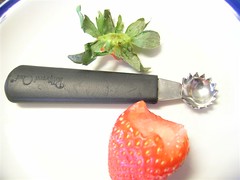
2. Legos. Okay, so I have a love/hate relationship with these vacuum hors d'oeuvres. My sons, however, adore the stuff. Their gratitude takes the form of a perpetual shrine to Ole Kirk Christiansen on the floor of their room.
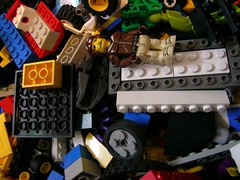
3. The small miracle that is running water. [New benefit to blogging: forces me to scrub kitchen faucet for photo op].

4. My watch. Because it's nice to know exactly how exactly how late I am.

5. The fifth food group.

6. Souvenirs/memories from Spain. (Yes I did notice the strategically-placed polka dots. Who could miss them?)
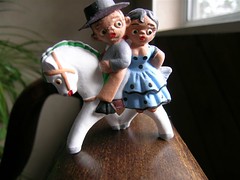
7. My lone defense against the demon drums of Isengard pounding in my head.

8. McKay'’s freckles. Aren't they adorable?
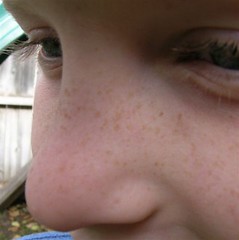
9. Baker's yeast -- a true testament to human ingenuity. Ancient Egyptian dude: "Hey some freaky living creatures from the air have landed in my flatbread dough and are making it bubble and froth. Gee, I think I'll bake it and eat it."
”
10. Modern tooth care. People used to scrub their teeth with sand! (Oh, wait, let me take a look at the toothpaste ingredients. Hydrated Silica? Hmmmm.)

11. This ring. (And the tall handsome guy who gave it to me).
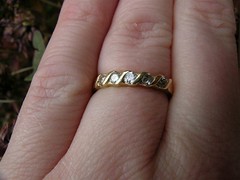
12. Four children, some of whom aren't so little any more.
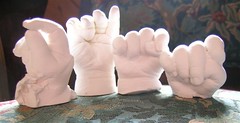
13. My digital camera. I wanted to take a picture of it, but was faced with a one-hand-clapping Zen quandary. How does one photograph the photograph-izer?
I could have used a mirror, I suppose. Duh. Why didn't I think of that sooner?
View More Thursday Thirteen Participants here
1. The coolest tool Pampered Chef ever made.

2. Legos. Okay, so I have a love/hate relationship with these vacuum hors d'oeuvres. My sons, however, adore the stuff. Their gratitude takes the form of a perpetual shrine to Ole Kirk Christiansen on the floor of their room.

3. The small miracle that is running water. [New benefit to blogging: forces me to scrub kitchen faucet for photo op].

4. My watch. Because it's nice to know exactly how exactly how late I am.

5. The fifth food group.

6. Souvenirs/memories from Spain. (Yes I did notice the strategically-placed polka dots. Who could miss them?)

7. My lone defense against the demon drums of Isengard pounding in my head.

8. McKay'’s freckles. Aren't they adorable?

9. Baker's yeast -- a true testament to human ingenuity. Ancient Egyptian dude: "Hey some freaky living creatures from the air have landed in my flatbread dough and are making it bubble and froth. Gee, I think I'll bake it and eat it."
”

10. Modern tooth care. People used to scrub their teeth with sand! (Oh, wait, let me take a look at the toothpaste ingredients. Hydrated Silica? Hmmmm.)

11. This ring. (And the tall handsome guy who gave it to me).

12. Four children, some of whom aren't so little any more.

13. My digital camera. I wanted to take a picture of it, but was faced with a one-hand-clapping Zen quandary. How does one photograph the photograph-izer?
I could have used a mirror, I suppose. Duh. Why didn't I think of that sooner?
View More Thursday Thirteen Participants here
Tuesday, November 21, 2006
The (broken) windmills of my mind
(Author’s note: apparently every post this week is going to involve Ethan. I didn’t intend it this way, but it’s funny how things work out. I should consider taking turns with each child. I do have four of them, so I could cover the month nicely with one per week. Something to think about…).
Ethan came into my room early this morning to tell me about a bad dream. George Bush was at our house with a construction crew in hopes of earning our vote through the old “home repair campaign strategy.” (Nice try George). The crew had just chopped down three of the giant old pine trees in our yard and replaced them with an elm. (Isn’t this SO like politicians?) Anyway, in the middle of his story, Ethan stopped and with a horrified look on his face, suddenly remembered that there was a test today to determine his school’s Knowledge Bowl teams.
“No big deal,” I assured him. “I’ll help you study during breakfast and I’ll rearrange the carpool and everything will be fine.” Then I began a mighty search for the Knowledge Bowl study guide, a search which took me through the various rooms of the house, the perpetual pile o' stuff on the kitchen counter, and the school-paper graveyard that is Ethan’s backpack. In the process I came across a note reminding parents that the deadline for applying to next year’s Junior High gifted program was November 13. As in the November 13 that was LAST WEEK. Now this was a big deal. A Very Big Deal.
I had never seen this note before, and more to the point, I had never seen the initial application that had apparently been distributed weeks before. Now the horrified look on Ethan’s face turned to tears and I felt like doing a little crying myself. It wasn’t so much the missed deadline that depressed him and frustrated me, but the pattern of forgetfulness that plagues Ethan’s young life. He is a very bright child, but he feels dumb sometimes because he can’t seem to keep track of things. Ask him anything about naval warfare or the engineering of bridges and he could write you a dissertation, but as for scout meetings, homework, and important notes that could impact his future, these bits of information just don’t stay tacked to the cluttered bulletin board that is his brain.
I am uniquely qualified to empathize with Ethan because I have the same problem. I am hopelessly scatterbrained. Ask anyone who knows me and they will nod their much more organized heads in agreement. Over the years I have learned to cope with my limitations. When I am running errands and planning to stop at the library, I get in the car and put the overdue books on my lap so I can’t miss them. When students ask me for a copy of something, I tell them “When I get home and I walk in the door and am attacked by my children who all need something at once, I will forget. I promise. So you must email me your request” (not that emails can’t be lost too, but I do better). My brain-of-steel husband keeps track of garbage day and does all the bills and car maintenance (I seriously have not filled up the car with gas more than twice in the last five years). And when I want to remember something, I stick post-it notes to my mirror, or the door, or my forehead. Notes like “Do not forget the baby” and stuff like that.
But Ethan has not developed the coping skills that I’ve acquired over a lifetime of hazardous brain lapses. It’s hard on him and I worry about his self-esteem on days like today. (By the way, I called the School District office and all will be forgiven and I can turn in the application late. The director of the gifted program said, “I guess 6th graders don’t make the best messengers.” She deals with her fair share of cluttered minds.)
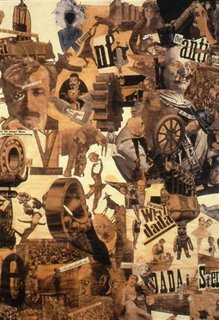 Most art is focused on a single scene or idea so I feel it doesn’t do enough to express the complex, multi-layered nature of human thought. Perhaps stream-of-consciousness writing and atonal modern music do a better job. But here’s a work that comes close. It’s a photomontage by the inventor of photomontage -- Hannah Höch. The actual title -- (are you ready for this?) Cut with the Kitchen Knife Dada through the Last Weimar Beer-Belly Epoch of Germany -- reflects the absurdity and political satire that marked the Dada art movement. But in many ways, I think the images and specifically the combination of images – the gears and wheels, the random words, the scattered glimpses of people, places, and events -- make a true portrait of the artist’s mind. All of these things have been cut into fragments and then pieced back together in an arbitrary jumble that makes sense only to the artist herself.
Most art is focused on a single scene or idea so I feel it doesn’t do enough to express the complex, multi-layered nature of human thought. Perhaps stream-of-consciousness writing and atonal modern music do a better job. But here’s a work that comes close. It’s a photomontage by the inventor of photomontage -- Hannah Höch. The actual title -- (are you ready for this?) Cut with the Kitchen Knife Dada through the Last Weimar Beer-Belly Epoch of Germany -- reflects the absurdity and political satire that marked the Dada art movement. But in many ways, I think the images and specifically the combination of images – the gears and wheels, the random words, the scattered glimpses of people, places, and events -- make a true portrait of the artist’s mind. All of these things have been cut into fragments and then pieced back together in an arbitrary jumble that makes sense only to the artist herself.
 My favorite detail: even Albert Einstein had a lot on his mind (apparently insects and train chassis). But now that I think about it, wasn’t Einstein a poor student and notoriously absent minded? I need to remember to tell Ethan this when he gets home from school.
My favorite detail: even Albert Einstein had a lot on his mind (apparently insects and train chassis). But now that I think about it, wasn’t Einstein a poor student and notoriously absent minded? I need to remember to tell Ethan this when he gets home from school.
Now where did I put those post-it notes?
Ethan came into my room early this morning to tell me about a bad dream. George Bush was at our house with a construction crew in hopes of earning our vote through the old “home repair campaign strategy.” (Nice try George). The crew had just chopped down three of the giant old pine trees in our yard and replaced them with an elm. (Isn’t this SO like politicians?) Anyway, in the middle of his story, Ethan stopped and with a horrified look on his face, suddenly remembered that there was a test today to determine his school’s Knowledge Bowl teams.
“No big deal,” I assured him. “I’ll help you study during breakfast and I’ll rearrange the carpool and everything will be fine.” Then I began a mighty search for the Knowledge Bowl study guide, a search which took me through the various rooms of the house, the perpetual pile o' stuff on the kitchen counter, and the school-paper graveyard that is Ethan’s backpack. In the process I came across a note reminding parents that the deadline for applying to next year’s Junior High gifted program was November 13. As in the November 13 that was LAST WEEK. Now this was a big deal. A Very Big Deal.
I had never seen this note before, and more to the point, I had never seen the initial application that had apparently been distributed weeks before. Now the horrified look on Ethan’s face turned to tears and I felt like doing a little crying myself. It wasn’t so much the missed deadline that depressed him and frustrated me, but the pattern of forgetfulness that plagues Ethan’s young life. He is a very bright child, but he feels dumb sometimes because he can’t seem to keep track of things. Ask him anything about naval warfare or the engineering of bridges and he could write you a dissertation, but as for scout meetings, homework, and important notes that could impact his future, these bits of information just don’t stay tacked to the cluttered bulletin board that is his brain.
I am uniquely qualified to empathize with Ethan because I have the same problem. I am hopelessly scatterbrained. Ask anyone who knows me and they will nod their much more organized heads in agreement. Over the years I have learned to cope with my limitations. When I am running errands and planning to stop at the library, I get in the car and put the overdue books on my lap so I can’t miss them. When students ask me for a copy of something, I tell them “When I get home and I walk in the door and am attacked by my children who all need something at once, I will forget. I promise. So you must email me your request” (not that emails can’t be lost too, but I do better). My brain-of-steel husband keeps track of garbage day and does all the bills and car maintenance (I seriously have not filled up the car with gas more than twice in the last five years). And when I want to remember something, I stick post-it notes to my mirror, or the door, or my forehead. Notes like “Do not forget the baby” and stuff like that.
But Ethan has not developed the coping skills that I’ve acquired over a lifetime of hazardous brain lapses. It’s hard on him and I worry about his self-esteem on days like today. (By the way, I called the School District office and all will be forgiven and I can turn in the application late. The director of the gifted program said, “I guess 6th graders don’t make the best messengers.” She deals with her fair share of cluttered minds.)
 Most art is focused on a single scene or idea so I feel it doesn’t do enough to express the complex, multi-layered nature of human thought. Perhaps stream-of-consciousness writing and atonal modern music do a better job. But here’s a work that comes close. It’s a photomontage by the inventor of photomontage -- Hannah Höch. The actual title -- (are you ready for this?) Cut with the Kitchen Knife Dada through the Last Weimar Beer-Belly Epoch of Germany -- reflects the absurdity and political satire that marked the Dada art movement. But in many ways, I think the images and specifically the combination of images – the gears and wheels, the random words, the scattered glimpses of people, places, and events -- make a true portrait of the artist’s mind. All of these things have been cut into fragments and then pieced back together in an arbitrary jumble that makes sense only to the artist herself.
Most art is focused on a single scene or idea so I feel it doesn’t do enough to express the complex, multi-layered nature of human thought. Perhaps stream-of-consciousness writing and atonal modern music do a better job. But here’s a work that comes close. It’s a photomontage by the inventor of photomontage -- Hannah Höch. The actual title -- (are you ready for this?) Cut with the Kitchen Knife Dada through the Last Weimar Beer-Belly Epoch of Germany -- reflects the absurdity and political satire that marked the Dada art movement. But in many ways, I think the images and specifically the combination of images – the gears and wheels, the random words, the scattered glimpses of people, places, and events -- make a true portrait of the artist’s mind. All of these things have been cut into fragments and then pieced back together in an arbitrary jumble that makes sense only to the artist herself.  My favorite detail: even Albert Einstein had a lot on his mind (apparently insects and train chassis). But now that I think about it, wasn’t Einstein a poor student and notoriously absent minded? I need to remember to tell Ethan this when he gets home from school.
My favorite detail: even Albert Einstein had a lot on his mind (apparently insects and train chassis). But now that I think about it, wasn’t Einstein a poor student and notoriously absent minded? I need to remember to tell Ethan this when he gets home from school. Now where did I put those post-it notes?
Monday, November 20, 2006
What good is a blog...
...if you can't use it to show off your kids' artwork?
Today I will share with you a work from my favorite living artist: Ethan, the Younger (1995 - present).
Salt Lake City (pencil on paper ca. last week)
Note the subtle use of linearity, a feature reminiscent of another artist of urban scenes, Edward Hopper. Rectangles and grids dominate the cityscape but are tempered by the more organic motif of arches that rise above the freeway, adorn the temple, and crown the “Billions and billions served” sign. Ethan’s style is characterized by fine attention to details such as windshield wipers on the car at the light and the concrete beams holding up the freeway. His finest detail, however is the juxtaposition of McDonald’s – symbol of human appetites – with the monument to spiritual ascension that is the Salt Lake Temple. He’s a genius.
Just for the sake of comparison, here’s something I drew when I was about his age.
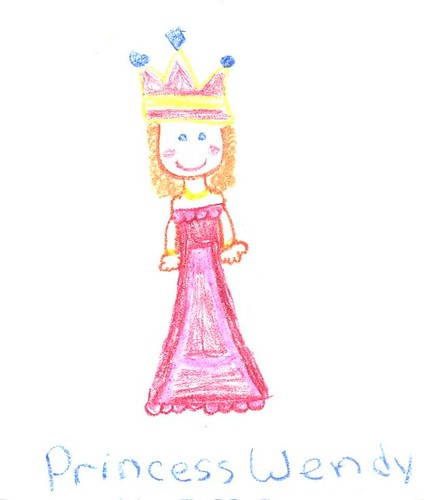
Obviously, when I carried the Artist Gene it was recessive. Also, I apparently used to hang out with royalty. Who knew?
Today I will share with you a work from my favorite living artist: Ethan, the Younger (1995 - present).
Salt Lake City (pencil on paper ca. last week)
Note the subtle use of linearity, a feature reminiscent of another artist of urban scenes, Edward Hopper. Rectangles and grids dominate the cityscape but are tempered by the more organic motif of arches that rise above the freeway, adorn the temple, and crown the “Billions and billions served” sign. Ethan’s style is characterized by fine attention to details such as windshield wipers on the car at the light and the concrete beams holding up the freeway. His finest detail, however is the juxtaposition of McDonald’s – symbol of human appetites – with the monument to spiritual ascension that is the Salt Lake Temple. He’s a genius.
Just for the sake of comparison, here’s something I drew when I was about his age.
Princess Wendy (crayon on paper ca. 1980)

Obviously, when I carried the Artist Gene it was recessive. Also, I apparently used to hang out with royalty. Who knew?
Saturday, November 18, 2006
Der Struwwelblog
It’s time for another edition of “Children’s books unsuitable for children.” This one is brought to you by my brother Scott (a.k.a. “He of the amazing memory”). Scott reminded me of a collection of stories called "Der Struwwelpeter" that my father used to read to us in the original German. Remarkably warped, these are cautionary tales meant to scare children into obedience, proper behavior and good hygiene. Think Mrs. Piggle-Wiggle joins the Gestapo. They don’t need much commentary, so just sit back and let the experience of it wash over you like a wave. A very very twisted wave.
Highlights from "Der Struwwelpeter"
Messy-head-Peter demonstrates what happens to little boys who do not comb their hair or trim their nails.
In an act of curiosity reminiscent of our monkey friend George, Pauline plays with matches and burns herself to a crisp. (I love the touching detail of her weeping cats next to the pile of ashes and empty little shoes).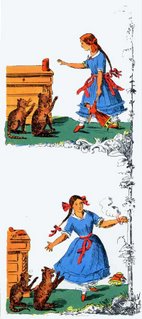
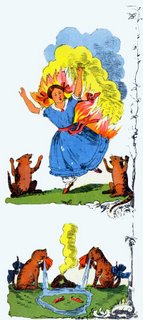
Augustus refuses to eat his soup and wastes away to nothing. Note to self: read this story to my picky eaters on a daily basis until appetites improve.
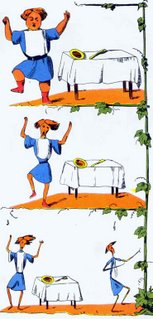
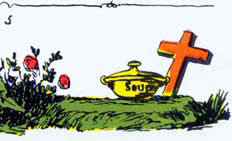
As evidence that A.D.D. existed in the 19th century, Johnny Head-in-Air isn’t paying attention to where he’s going and he winds up swimming with the fishes.
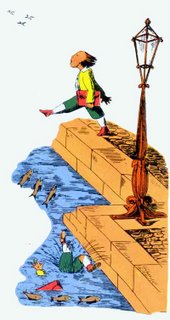
And the piece de resistance (or whatever is the German equivalent): Konrad is cured from his thumb-sucking habit through a most…um…effective method. Beware the tall tailor with giant scissors.

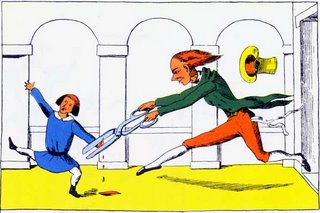

My brother claims we begged Dad to read us these stories. I do not remember this. But then again, I have (through years of extensive therapy no doubt) managed to block out the entire book. My sister Kathy (a.k.a. “She of the one-time thumb sucking habit”) however, was traumatized for life.
(To see the whole text, go here or here)
Highlights from "Der Struwwelpeter"
Messy-head-Peter demonstrates what happens to little boys who do not comb their hair or trim their nails.

In an act of curiosity reminiscent of our monkey friend George, Pauline plays with matches and burns herself to a crisp. (I love the touching detail of her weeping cats next to the pile of ashes and empty little shoes).


Augustus refuses to eat his soup and wastes away to nothing. Note to self: read this story to my picky eaters on a daily basis until appetites improve.


As evidence that A.D.D. existed in the 19th century, Johnny Head-in-Air isn’t paying attention to where he’s going and he winds up swimming with the fishes.

And the piece de resistance (or whatever is the German equivalent): Konrad is cured from his thumb-sucking habit through a most…um…effective method. Beware the tall tailor with giant scissors.



My brother claims we begged Dad to read us these stories. I do not remember this. But then again, I have (through years of extensive therapy no doubt) managed to block out the entire book. My sister Kathy (a.k.a. “She of the one-time thumb sucking habit”) however, was traumatized for life.
(To see the whole text, go here or here)
Subscribe to:
Posts (Atom)




